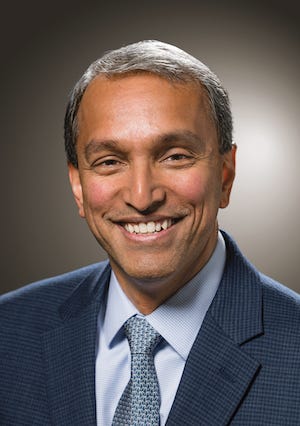CIO Moves: Deere & Co's New CIO Talks Strategy, Trends, and Career Paths
The agricultural and construction equipment giant has named two insiders as CIO and CFO as it looks toward the mega trends of sustainability and automation.

Agricultural and construction equipment giant Deere & Co. has appointed Ganesh Jayaram as chief information officer, effective this month. But the action doesn’t really signal a change in direction for the technology operations at the company, which ranked 84 on the Fortune 500 list in 2022.
Jayaram comes to the job from inside Deere, where he has served as VP of IT since 2016 leading the “Agile Operating Model Transformation,” a shift for the company from a “projects to products” focus.
InformationWeek caught up with Jayaram to talk about his career, the strategy ahead for Deere, and the forces in the market that will be impacting the company in the months ahead.

Ganesh Jayaram, CIO of Deere & Co.
Deere’s IT Strategy
The Agile Operating Model is Deere’s move from the Waterfall development model to an Agile model that Jayaram spearheaded as VP of IT.
Jayaram tells InformationWeek that this is the accomplishment he’s most proud of over the course of his career.
“It’s a wholesale transformation of the IT function,” he says. “It’s a partnership between the IT function and our partners in the rest of the business.”
That explains the high level, but there’s a deeper philosophy behind it that many businesses have pursued. Deere is no exception. Jayaram explains that the Waterfall model puts a lot of value-creation at the end of the project and makes IT subservient to the business by having it turn over all the features they want to the IT team at the start of the engagement. The business side is not as involved as the development happens, except for maybe quarterly updates on progress.
“As part of the operating model, we have shifted from projects to products,” Jayaram says. “It might sound like this is just a semantic shift, but it’s not. It is actually the underpinning for how we have reorganized ourselves into product-based teams.”
Deere’s IT is seeking to follow a model that looks something like software as a service (SaaS) in that the team will continue to develop updates and improvements to an application or product continually rather than as one single release that comes out once a year or once every two or three years.
“Teams stay engaged through the entire lifecycle and are responsible for continual upgrades,” he says. There’s no construct of, ‘hey, I’ve done this project, I’m going to leave the team and do something else now.’”
This reorganization of the IT function also keeps IT more closely engaged with their business users, something that Jayaram says is truly the most important aspect of the transformation.
Market Trends
Jayaram says that there are three major trends right now. First is focusing in on the market opportunities. As Deere leadership has said before, the company leadership believes they are in position to improve their customers’ profitability and productivity, so that means there’s a lot of opportunity to sell more to existing customers in the market.
Second, Jayaram says that sustainability is a mega trend for companies, and that’s something that Deere plans to address in terms of both its own operations and the equipment that it makes that is used in construction and farming operations, and also in internal IT operations.
Third is the trend of automation. That’s been significant for Deere customers who have relied on updated equipment that incorporates automation. But in terms of Jayaram’s IT organization, there’s also automation work to be done.
“We are trying to drive decision-making in real time at the edge. It’s not just machines, but in our factories, in our warehouses, doing a lot of real-time analytics that improves the quality of our operations,” Jayaram says.
The Best Preparation for CIO Role
Jayaram says that his long years on the business side of Deere were what best prepared him for his new role as CIO.
He held several roles at Deere since he started at the company in 2006, and most of them were not in IT, but rather on the business side -- as a VP of corporate strategy, as the global director of the cotton harvesting equipment line, and as VP of sales and marketing for the Ag & Turf division in Asia and Sub-Saharan Africa. He explains why that background has been an advantage.
“Because first and foremost, technology for technology’s sake is never an ideal outcome. You are looking to invest in technologies as a means to drive differentiated business outcomes and value for your stakeholders -- your end users or any of your different constituents of the IT function,” he says. “Coming in with that rich vein of business experience across sales and market and product manufacturing and engineering and corporate strategy gave me a better appreciation of who our customers are, what our purpose is, and the role that technology can play and does play in improving the lives of all those different stakeholders.”
“If you think about the jobs that best prepared me, I would say that every single role that I’ve had since I came into the company progressively prepared me to take on more of these responsibilities,” he says.
Jayaram succeeds Raj Kalathur as CIO at Deere. Kalathur has moved into the role of CFO for the company, and he also retains his duties as president of John Deere Financial and continues oversight of IT.
What to Read Next:
Interim CIOs Favored as Organizations Seek Digitalization Push
The Restructuring CIO: Transforming How IT Works
SAP’s CTO Juergen Mueller Talks Transformation and Evolution
About the Author
You May Also Like






